Seagate BarraCuda Pro 14TB HDD Review: Massive Storage for Desktops
by Ganesh T S on September 10, 2018 8:01 AM ESTPerformance - Internal Storage Mode
The performance of an internal storage device is dependent on the performance characteristics of the device as well as the file system being used. In order to isolate the effects of the latter, we first benchmarked the raw drives using HD Tune Pro 5.70. It was then formatted in NTFS and subject to our standard direct-attached benchmark suite.
Raw Drive Performance
HD Tune Pro allows us to run a variety of tests to determine transfer rates and IOPS for various artificial workloads. In addition, it also allows us to visualize how the performance varies as the tracking head moves from the outer parts of the platter towards the center (i.e, transfer rates as a function of the block address).
Empty drives are bound to perform very well, but, depending on the location of the data in the drive, we find that access rates can go as low as 117 MBps for sequential workloads (compared to the 112 MBps of the 12TB drive from last year). Write access times are a bit unpredictable due to the multi-segmented cache.
Random accesses are never the strong points of hard drives, and we see that the BarraCuda Pro delivers around 69 IOPS for 4K random reads and 222 IOPS for 4K random writes. The random read performance is very similar to the performance of the 12TB version from last year, while the random write performance receives a boost up from 191 IOPS.
The extra tests help in putting some numbers to sequential accesses targeting different areas of the drive. It also provides some interesting numbers relevant to various random access workloads.
DAS Benchmarks
Consumers opting for drives such as the 12TB Seagate BarraCuda Pro typically need high-capacity local storage for holding and editing / processing large-sized multimedia files. Prior to taking a look at the real-life benchmarks, we first check what CrystalDiskMark has to report for the drive. The numbers are in the same ballpark as the 12TB version from last year.
In order to tackle the real-life use-case of transferring large amounts of data back and forth from the drive, we created three test folders with the following characteristics:
- Photos: 15.6 GB collection of 4320 photos (RAW as well as JPEGs) in 61 sub-folders
- Videos: 16.1 GB collection of 244 videos (MP4 as well as MOVs) in 6 sub-folders
- BR: 10.7 GB Blu-ray folder structure of the IDT Benchmark Blu-ray (the same that we use in our robocopy tests for NAS systems)
| Seagate BarraCuda Pro 14TB robocopy Benchmarks (MBps) | ||
| Write Bandwidth | Read Bandwidth | |
| Photos | 197.81 | 206.81 |
| Videos | 219.51 | 206.99 |
| Blu-ray Folder | 222.00 | 212.36 |
These numbers are better than the ones we obtained for the 10TB version from 2016, but, fall a little short of the performance of the 12TB drive from last year.
While processing our DAS suite, we also recorded the instantaneous transfer rates and temperature of the drive. Compared to typical disk drives, the write transfers show higher instantaneous speeds due to a combination of the firmware and the 256 MB cache inside the drive. However, sustained write rates are comparable to other high-capacity drives when the cache is exhausted. The temperature of the unit at the end of the transfers (more than 250GB of traffic) rose by less than 4C, pointing to the power-efficiency of the platform.
For the use-case involving editing of multimedia files directly off the disk, we take advantage of PCMark 8's storage benchmark. The storage workload is a good example of a user workload, involving games as well as multimedia editing applications. The command line version allows us to cherry-pick storage traces to run on a target drive. We chose the following traces.
- Adobe Photoshop (Light)
- Adobe Photoshop (Heavy)
- Adobe After Effects
- Adobe Illustrator
Usually, PCMark 8 reports time to complete the trace, but the detailed log report has the read and write bandwidth figures which we present in our performance graphs. Note that the bandwidth number reported in the results don't involve idle time compression. Results might appear low, but that is part of the workload characteristic.
| Seagate BarraCuda Pro 14TB PCMark8 Storage Benchmarks (MBps) | ||
| Write Bandwidth | Read Bandwidth | |
| Adobe Photoshop (Light) | 248.16 | 9.01 |
| Adobe Photoshop (Heavy) | 233.95 | 11.03 |
| Adobe After Effects | 89.93 | 8.73 |
| Adobe Illustrator | 202.41 | 8.47 |
Compared to the results from the 12TB drive last year, we find that the read workloads fare very similarly, but, the write workloads have a slight edge.


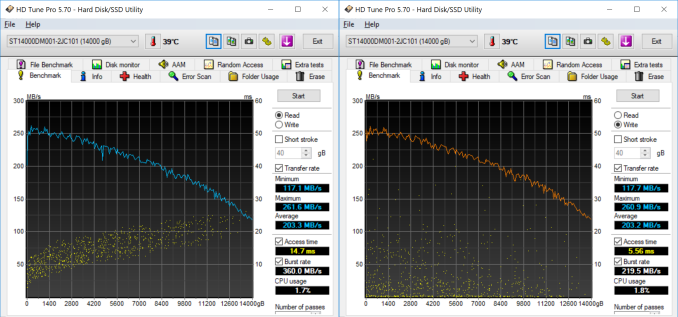
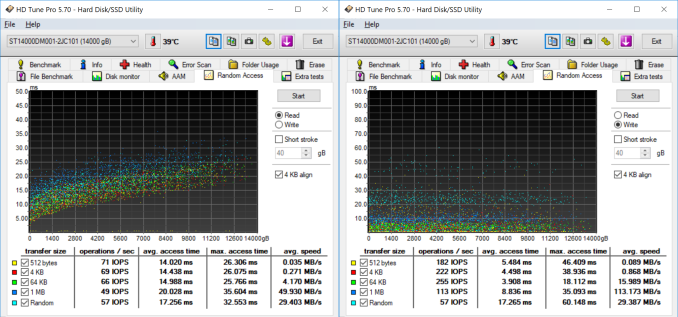
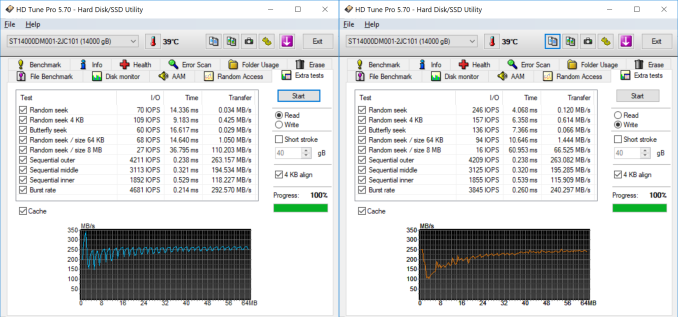
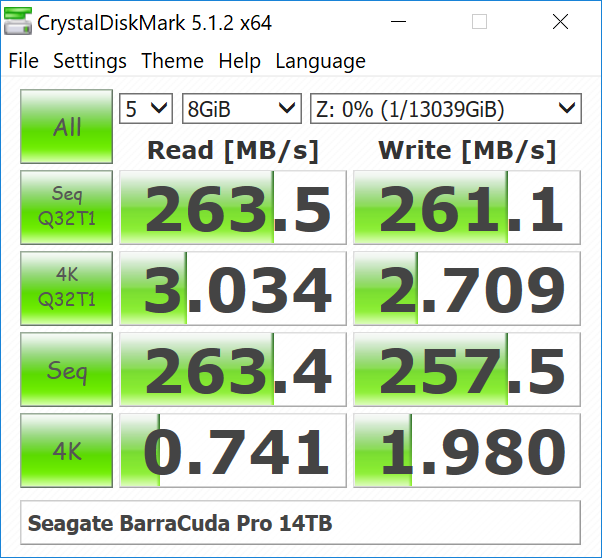
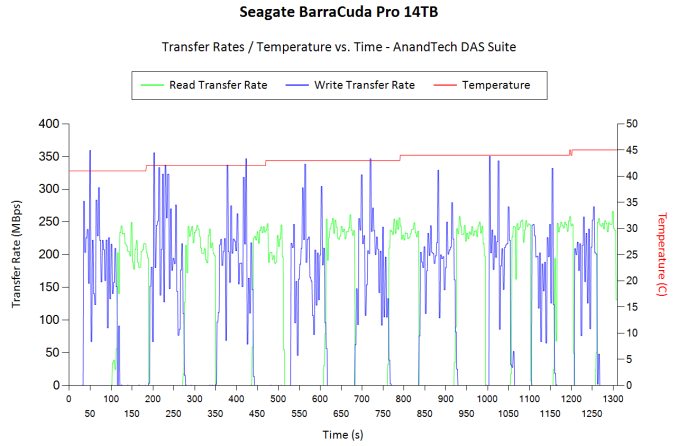








65 Comments
View All Comments
czartech - Tuesday, October 16, 2018 - link
take a raspberry pi and install pi-hole. no more ads!svan1971 - Monday, September 10, 2018 - link
I remember how bad I felt when my 4GB Western Digital drive on my Gateway 2000 P5-75 running Windows 95 failed. I lost all that data. I wonder what its like loosing 14 TB.DanNeely - Monday, September 10, 2018 - link
A similar loss of an old 4gb drive back in 2004 taught me the value of backups. Any data I really care about is on at least 2 independent drives. If my desktop dies, I can restore from my NAS, if my NAS dies I can restore from my desktop, some stuff (eg music) is also on my laptop and phone. More critical stuff is also backed up to the cloud, it's a subset of everything both for cost reasons and because for privacy related ones I refuse to upload full system images.wumpus - Monday, September 10, 2018 - link
If you care about your data, you need to have another drive as backup. Although with 14TB (even more if building an array out of 14TB drives), you might well be into LTO tape land for your backup needs.stephenbrooks - Monday, September 10, 2018 - link
Yeah this is the problem with drives costing $500 is that you then need to buy 2 or 3 of them to have good backups!mapesdhs - Wednesday, September 12, 2018 - link
Slightly earlier generations of LTO are looking quite good these days, a fair few used drives on ebay. LTO4 looks optimal price-wise, though of course a single tape is nowhere near enough to archive one of these modern rust spinners, but sensible use of subfolders can take care of that. If you really care about your data, LTO5 isn't that expensive, new units on ebay UK atm for 225 UKP. Used prices do jump a lot for LTO6, though ironically the last new LTO6 tape I bought off ebay only cost me 11 UKP. :DAnd of course, suitabe used SAS cards cost diddly squat.
Either way, the problem with using extra rust spinners as backups is they're prone to the same issues such as shock, mechanism degradation, etc. If you do go that route though, always buy the extra drives from different sources, helps ensure the drives come from different batches (that way if there's a batch fault, it's less likely to affect more than one of your drives).
29a - Monday, September 10, 2018 - link
4GB would have been quite a hefty drive for a P75.boozed - Monday, September 10, 2018 - link
Are you suggesting that the smaller drives don't use helium because they're heavier?!DanNeely - Monday, September 10, 2018 - link
AFAIK one the advantages of helium filled drives include being able to use thinner (and thus lighter) platters and less powerful motors (and lighter on a per platter basis, not sure about net) due to the lower air resistance.boozed - Monday, September 10, 2018 - link
Right, thanks for the explanation. The way it's excited in the article is quite ambiguous IMO.